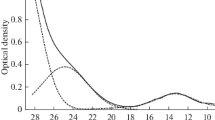Abstract
The oxygen coefficient (O/U atomic ratio) of the cathodic product prepared by potentiostatic electrolysis of tungstate melts was studied in relation to the electrolyte composition, deposition potential, temperature of electrolysis, and cation of the solvent salt. With increasing temperature, the oxygen coefficient of the cathodic product increases. With shifting the deposition potential toward more negative potentials, with increasing concentration of W2O 2−7 anions, and with decreasing concentration of UO2WO4 in the tungstate electrolytes, uranium oxides with smaller oxygen coefficients are formed. The oxygen coefficient decreases with increasing radius of the salt cation, other conditions being equal. The abnormal behavior of melts based on Li2WO4 is probably due to lower activity of O2− anions capable to form strong Li3O+ complexes with lithium cations in the melt. The experimental results can be accounted for using the model of the ionic composition of uranyl-containing tungstate melts based on the concepts of complexation and stepwise solvolysis of uranyl ions.
Similar content being viewed by others
References
Afonichkin, V.K., Komarov, V.E., and Vakarin, S.V., Elektrokhimiya, 1993, vol. 29, no. 11, pp. 1356–1359.
Afonichkin, V.K., Komarov, V.E., Khrustova, L.G., and Vakarin, S.V., Radiokhimiya, 2001, vol. 43, no. 3, pp. 224–229.
Mokhosoev, M., Alekseev, F.P., and Lutsyk, V.I., Diagrammy sostoyaniya molibdatnykh i vol’framatnykh sistem (Phase Diagrams of Molybdate and Tungstate Systems), Novosibirsk: Nauka, 1978.
Nomure, Y., Kamegashira, N., and Naito, K., J. Cryst. Growth, 1981, vol. 52, pp. 279–284.
Afonichkin, V.K., Khokhlova, A.M., Komarov, V.E., and Leont’ev, V.N., Abstracts of Papers, VIII Kol’skii seminar po elektrokhimii redkikh metallov (VIII Kola Workshop on Electrochemistry of Rare Metals), Apatity, 1995, pp. 5–6.
Afonichkin, V.K., Leont’ev, V.N., and Komarov, V.E., Elektrokhimiya, 1993, vol. 29, no. 3, pp. 341–347.
Afonichkin, V.K., Komarov, V.E., Khokhlova, A.M., and Leont’ev, V.N., Abstracts of Papers, X Vsesoyuznaya konferentsiya po fizicheskoi khimii i elektrokhimii ionnykh rasplavov i tverdykh elektrolitov (XI All-Union Conf. on Physical Chemistry and Electrochemistry of Ionic Melts and Solid Electrolytes), Yekaterinburg, 1992, pp. 47–48.
Afonichkin, V.K., Komarov, V.E., and Khrustova, L.G., Abstracts of Papers, III Rossiiskaya konferentsiya po radiokhimii (III Russian Conf. on Radiochemistry), St. Petersburg, 2000, pp. 18–19.
Afonichkin, V.K., Komarov, V.E., Khrustova, L.G., and Vakarin, S.V., Abstracts of Papers, Problemy elektrokristallizatsii metallov (Problems of Electrolytic Crystallization of Metals), Yekaterinburg, 2000, pp. 56–57.
Cordfunke, E.H.P., J. Inorg. Nucl. Chem., 1965, vol. 31, no. 5, pp. 1542–1543.
Afonichkin, V.K., Komarov, V.E., Leont’ev, V.N., and Nekrasova, N.P., Elektrokhimiya, 1996, vol. 32, no. 7, pp. 800–805.
Zakhar’yash, S.M., Cand. Sci. (Chem.) Dissertation, Sverdlovsk, 1982.
Smirnov, V.M., Elektrodnye potentsialy v rasplavlennykh khloridakh (Electrode Potentials in Molten Chlorides), Moscow: Nauka, 1973.
Voronov, N.M., Sofronova, R.M., and Voitekhova, E.A., Vysokotemperaturnaya khimiya okislov urana i ikh soedinenii (High-Temperature Chemistry of Uranium Oxides and Their Compounds), Moscow: Atomizdat, 1971.
Iwai, S., Ossaka, J., and Okada, K., Kobutsugaku Zasshi, 1980, vol. 14 (Tokubetsugo 2), pp. 60–70.
Miyake, M., Ossaka, J., Iwai, S., et al., J. Chem. Soc., Faraday Trans., 1978, vol. 74, no. 10, pp. 1880–1884.
Author information
Authors and Affiliations
Additional information
Original Russian Text © V.K. Afonichkin, V.E. Komarov, L.G. Khrustova, 2006, published in Radiokhimiya, 2006, Vol. 48, No. 2, pp. 128–133.
Rights and permissions
About this article
Cite this article
Afonichkin, V.K., Komarov, V.E. & Khrustova, L.G. Influence of the electrolysis conditions and composition of electrolytes in the M2WO4-M2W2O7-UO2WO4 system (M = Li, Na, K, Cs) on the oxygen coefficient of uranium oxide. Radiochemistry 48, 141–147 (2006). https://doi.org/10.1134/S1066362206020068
Received:
Issue Date:
DOI: https://doi.org/10.1134/S1066362206020068




